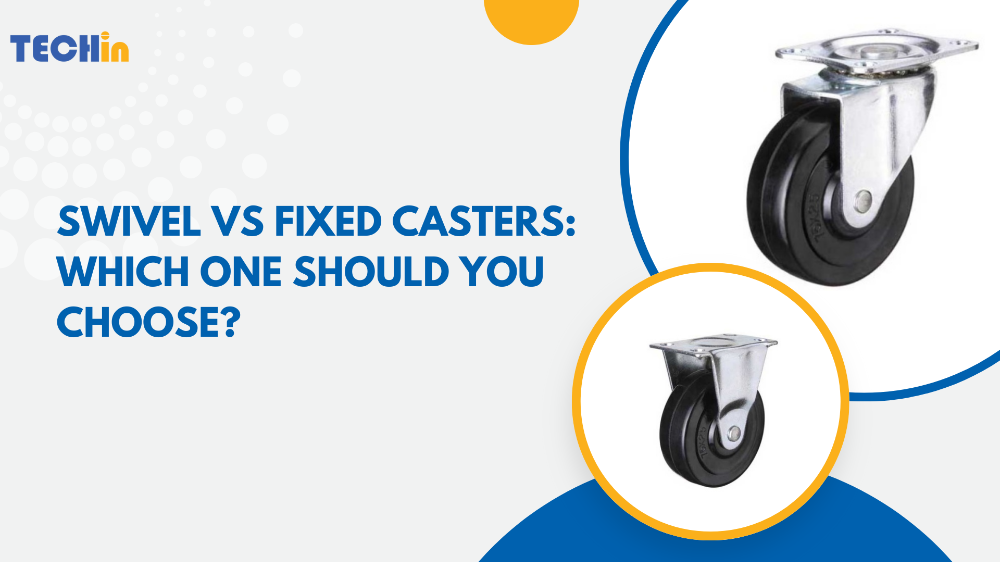When you’re choosing casters for your project, whether it’s for office furniture, industrial carts, or even home appliances, the right type can make a huge difference in your mobility, load-bearing capacity, and maneuverability. Swivel and fixed casters each have their own advantages. In this guide, we’ll look at the key differences, benefits, and help you make an right decision.
Swivel vs Fixed Casters

Swivel casters rotate 360 degrees, making them ideal for maneuvering in tight spaces. They offer greater agility, but may not support heavy loads as well as fixed casters.
Fixed (rigid) casters provide straight-line movement and are typically stronger, offering better load support. Swivel casters are great for environments requiring flexibility, while fixed casters are better suited for heavy-duty applications.
Now that we’ve covered the basics, let’s dive deeper into their structures, features, and which one might be best for your particular needs.
What Are the Different Types of Casters?

There are two main types of casters you’ll encounter:
- Fixed (Rigid) Casters:
- These casters are non-rotating and move only in a straight line. They’re great for stability and heavy-duty tasks.
- Commonly used on larger equipment, industrial carts, or any situation requiring straight-line movement.
- Swivel Casters:
- Swivel casters rotate 360 degrees, offering the flexibility to move in any direction.
- These are often used in environments where agility is key, such as hospitals, offices, or retail settings.
What Is the Difference Between Rigid and Swivel Casters?
Structure and Appearance:
- Swivel casters feature a pivoting mechanism, usually with ball bearings, allowing them to rotate freely.
- Fixed casters are designed with a rigid frame, meaning the wheel does not turn independently from the mounting.
Features:
- Swivel casters are known for their mobility and flexibility, ideal for environments requiring frequent turns or movement in tight spaces.
- Fixed casters provide greater load-bearing capacity and stability, ideal for straight-line movement or when carrying heavier items.
Uses:
- Swivel casters are perfect for small spaces, where maneuvering is essential, such as in narrow aisles or crowded workshops.
- Fixed casters are typically used where straight-line travel is needed, such as on large carts or equipment.
What Are the Benefits of Swivel Casters?
- Enhanced Mobility: Swivel casters allow for smooth, easy movement in any direction, which is perfect for navigating tight spaces or changing directions quickly.
- Agility: Their ability to pivot makes them a top choice in environments like hospitals, warehouses, and retail spaces where quick maneuvering is critical.
- Versatility: Swivel casters are adaptable to a wide range of applications, making them a go-to for everything from office chairs to heavy-duty carts.
What Are the Advantages of Fixed Casters?
- Greater Strength: Fixed casters are generally stronger than swivel casters and can support heavier loads due to their rigid design.
- Stability: Fixed casters are best for situations that demand straight-line movement, such as industrial carts or machinery.
- Lower Rolling Resistance: Because fixed casters don’t rotate, they experience less friction and require less effort to move straight, making them ideal for moving heavy items over long distances.
How Do I Choose the Right Casters?

The right choice depends on your specific needs:
- Choose fixed casters when you need stability and heavy load-bearing capacity. These are ideal for large carts, industrial equipment, and situations where straight-line movement is critical.
- Choose swivel casters when you need agility and maneuverability in tight spaces. These are perfect for furniture, office chairs, and mobile workstations.
Consider factors such as:
- Load capacity: Ensure the casters can support the weight of the equipment or items.
- Space constraints: Smaller spaces benefit from the maneuverability of swivel casters, while fixed casters are better for wider, open areas.
- Surface type: Different casters work best on different surfaces (e.g., polyurethane for concrete floors, rubber for tile).
Should All Four Casters Be Swivel?
A common setup is to use two fixed and two swivel casters, providing a good balance of stability and maneuverability. This setup is often seen in carts, where the fixed casters keep the direction straight, and the swivel casters allow for steering.
However, in smaller spaces with tight corners or where you need to move your equipment sideways, all four casters may need to be swivel. This setup allows the cart to pivot in any direction, making it easier to navigate narrow aisles or corners.
Summary
When it comes to choosing between swivel and fixed casters, it really comes down to what you need in your environment. If you need flexibility and maneuverability, swivel casters are the way to go. If you need strength, load-bearing capacity, and straight-line movement, fixed casters are the better option. Think about your space, your load, and how you need to move when you’re choosing the right caster for your application.






